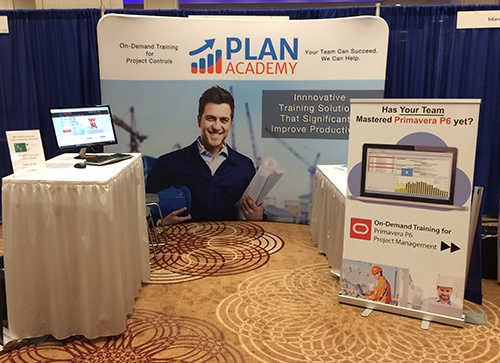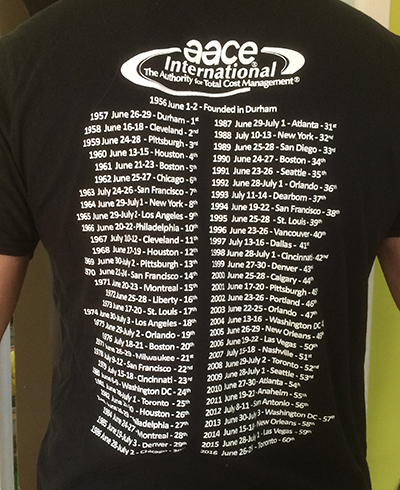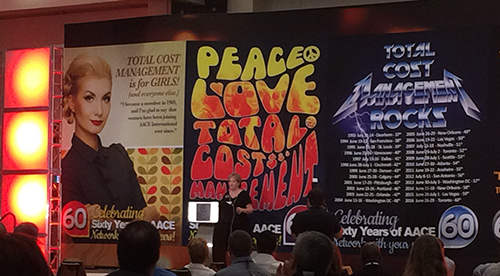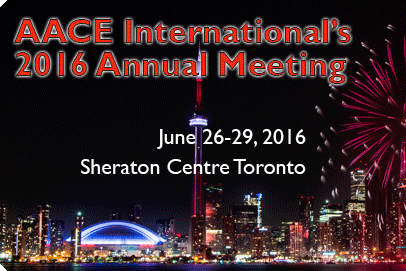Admittedly, it took us weeks to prepare for. I really wasn’t sure we would make it. There was so much to do. Brochures were designed & drawn up, backdrops architected and printed, boxes of business cards were ordered arrived by courier and a myriad of other essentials were procured.
We were running our very first tradeshow booth.
Being primarily an online company, I didn’t realize until this year’s AACE Annual General meeting in Toronto (June 26-29, 2016) how little I had in print about Plan Academy. We’ve been in business for 4 years, but other business cards, I didn’t have anything to hand an interested party who would amble by our booth on the tradeshow floor. Yes, this is a bit of a side-story, but I will get to what I learned at the AACE conference very soon.
So, I set about getting ready the marketing things you need to have ready for a tradeshow; giveaways, brochures, pull-up banners, a computer ready for a live demo, prepare a talk, and on and on.
 If I can share 3 axioms on how to run a tradeshow booth with even a little success.
If I can share 3 axioms on how to run a tradeshow booth with even a little success.
Talk
You have to talk a lot. In fact you want to talk a lot. To who ever you can.
Stand
You have to stand a lot. Like, a lot. Your feet will hurt, but do it anyway. Stand and be ready to talk to someone. Be ready.
Take notes
Most of you probably thought this 3rd item was Drink, but this is a professional blog ;). When you meet someone interesting, you jot down notes about them so you can recall what you spoke about when you follow up with them. Very essential stuff.
That’s enough of that. Let’s talk about what I learned.
AACE Project Controls Conference: 5 Things I Learned
I’m a recent member of the AACEi – the Association for the Advancement of Cost Engineering for those of you who weren’t sure. I’ve been a member since last year. If you want to find out what an association is like and what they are about and should you join, then I highly recommend you go to their annual conference. I stand by this rule and have used it to assess investing in some major software packages in the past, by attending the provider’s annual conference. You get to see firsthand what people who are involved in the association like and don’t like. You can feel-out the energy of the place, so to speak.
This is not an ad for the AACE, but I wrote this article almost as answer to the frequent question I’m posed – “What advice do you have for someone starting out in project controls? Where should I get involved?”
#1 – Cost AND Project Controls
You might think AACE is primary for cost professionals, but that’s not my assessment. This is where many seasoned project controls professionals are hanging out. In fact, in the exhibitor prospectus, it cites that 41% of conference attendees are in project controls or planning/scheduling, while only 36% are in a cost-related role.
They’re talking about cost estimating, cost management, risk analysis, construction delay claims, scheduling and project controls in general. This is a different crowd than the one you’ll find at PMI chapter meetings. The focus is project controls, cost management and related topics. All good stuff for you and me.
#2 – AACE vs PMI (briefly)
What you can learn from the back of a T-shirt. The AACE was founded in 1956 in Durham, North Carolina, so it’s 60 years young but has had a long life to accumulate knowledge in project controls and cost engineering. Membership count is around 10,000 worldwide and there are local sections in many of the world’s large centers.
 PMI was founded 13 years later in 1969, so PMI might actually be considered a younger cousin, even though membership numbers in PMI are at least 10x more than AACE (I have no solid references here on membership numbers, just going by hear-say, but I’m sure the data is not far off).
PMI was founded 13 years later in 1969, so PMI might actually be considered a younger cousin, even though membership numbers in PMI are at least 10x more than AACE (I have no solid references here on membership numbers, just going by hear-say, but I’m sure the data is not far off).
The point here is that PMI, with such a huge membership base, has had to dilute its practices somewhat to be inclusive of so many industries. While AACE has been primarily focused on serving project / cost controls professionals in construction, engineering, oil/gas, defense and aerospace. The result is that the community is tighter, and the teachings and knowledge are much more relevant and easier to apply.
#3 AACE’s Is A Technical Conference
Different from any other conferences I’ve been to, a technical conference requires presenters to write a paper. It’s almost like in academia where PhDs write papers to publish in a scientific journal. If I understand it right, the paper and the presentation cannot be a commercial for a piece of software or a vendor. I’ve been to conferences where all you get is presentations by vendors extolling their prowess and solutions. Here, papers are reviewed by a technical committee and scored to determine if they are approved.
What I like best is that in the end, after the conference, you are not left with a slide deck that is virtually unusable without the presenter’s narrative. Instead, you get a well-written paper that argues and explains a concept or a point, a paper that can be referenced and that has some staying power. This is what makes a technical conference worth attending. You get ALL the papers in the end to add to your library.
#4 Software Solutions are Rapidly Evolving
 Since I spent a lot of time on the tradeshow floor at the AACE Project Controls Conference, I had the chance to speak with many software vendors in the project controls space. I find one of the benefits of attending conferences is that you get a real good look at what’s happening in the software solutions arena. Innovation is big and the software we’re using today will not be the software we use tomorrow. Items to explore include:
Since I spent a lot of time on the tradeshow floor at the AACE Project Controls Conference, I had the chance to speak with many software vendors in the project controls space. I find one of the benefits of attending conferences is that you get a real good look at what’s happening in the software solutions arena. Innovation is big and the software we’re using today will not be the software we use tomorrow. Items to explore include:
- BIM
- Real-time scheduling solutions
- Integrated cost & schedule solutions
- Risk Analysis tools
- CPM Scheduling tools.
I could write a book on what I saw, but I’ll have to cut it short to get through this post.
#5 Primavera P6 Longest Path Issues
So I did make it to a very informative presentation on Longest Path deficiencies in Primavera P6 and Microsoft Project. This was truly fascinating from my perspective and I sort of commandeered the microphone during the after-question period (sorry!). I’ve known about some of these Longest Path problems, but somehow I also believed they had been fixed in more recent versions of P6….I was completely wrong.
But I’ll have to leave you hanging there. I’ll be writing the whole thing up soon here on the blog.
Wrap-Up
I’m not on AACE’s payroll. But I would recommend that you check it out if you are not a member. I’m sort of kicking the tires right now myself, but so far I like what I see and I feel more at home than at PMI.
Conferences always provide great opportunities to learn and explore, meet great people and talk about challenges. I talked to so many people that last week of June that I put myself in a cone of silence for 2 days afterward. If you can make it to next year’s conference, you might be surprised at how well you fit in. Maybe we will cross paths.
Bit of a side note, but I should mention that Plan Academy was also able to establish some new partnerships that are leading to some exciting developments in training. I can’t share too much right now, but there’s more coming shortly.

